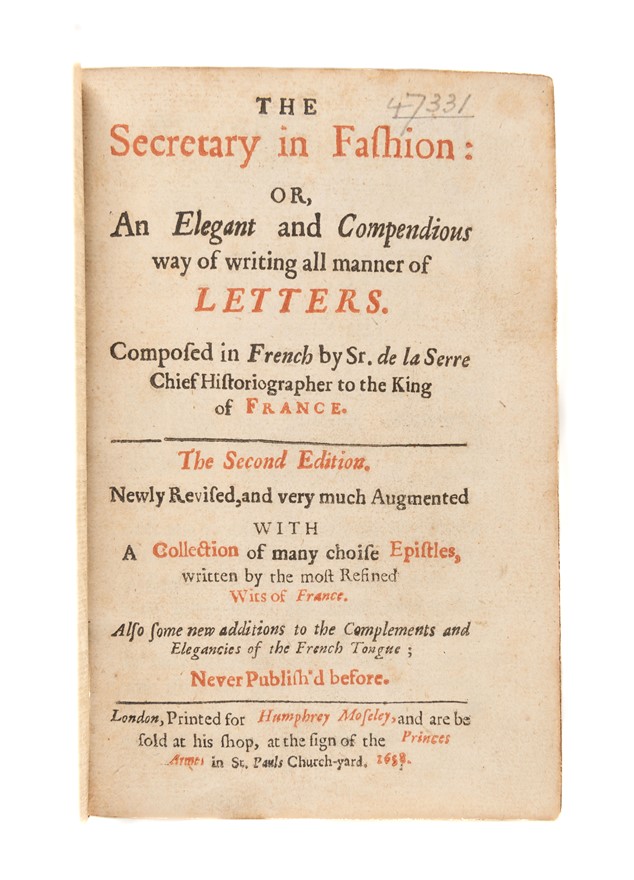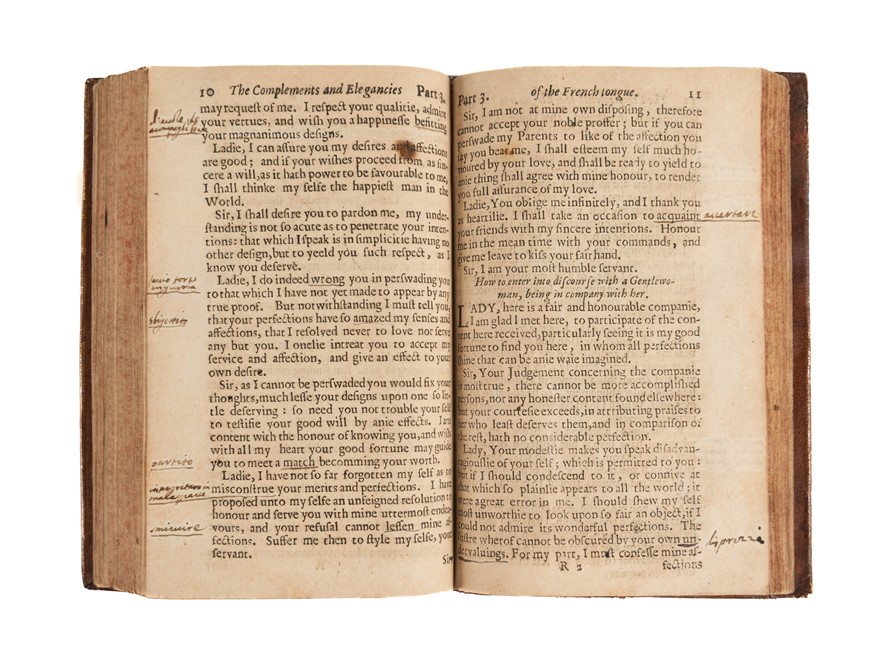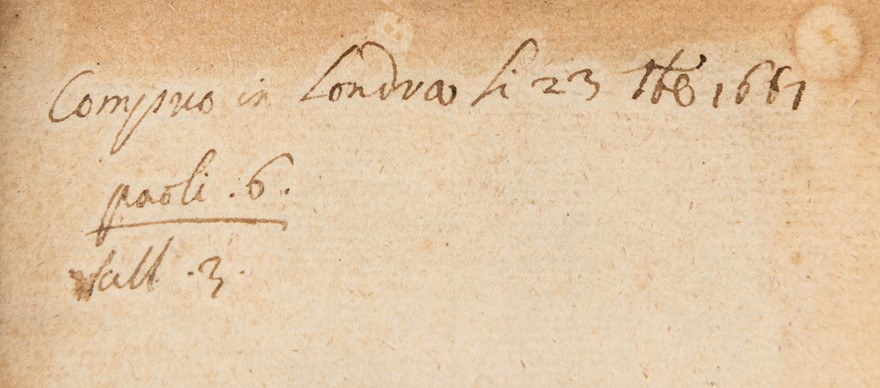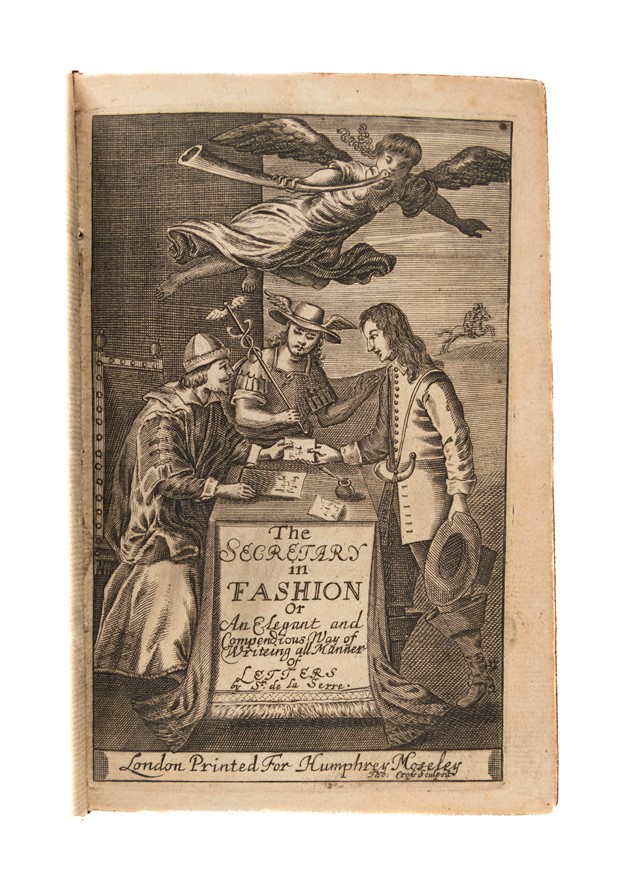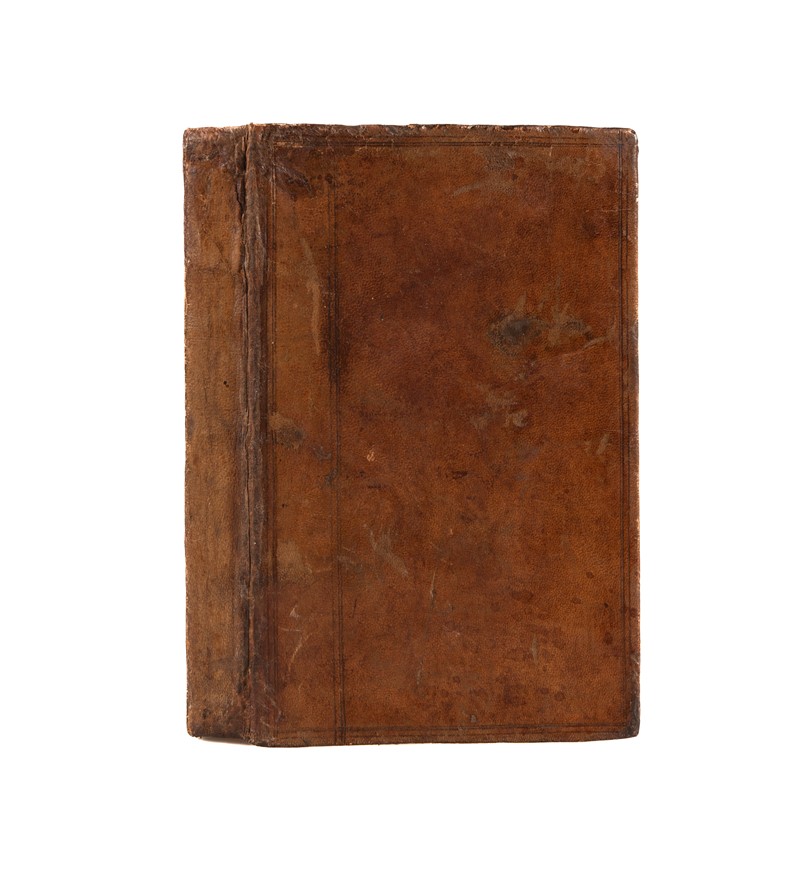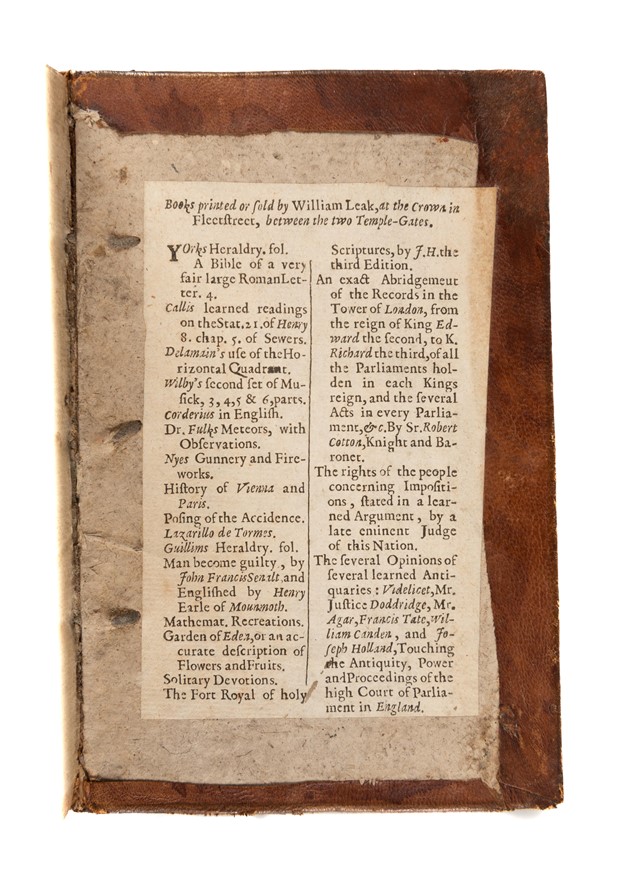The Secretary in Fashion:
LA SERRE Jean Puget de (1658)
£2800.00
Please contact us in advance if you would like to view this book at our Curzon Street shop.
BOUGHT BY AN ITALIAN VISITOR IN LONDON IN 1661 AND ANNOTATED WITH ITALIAN EQUIVALENTS FOR MANY OF THE ENGLISH WORDS AND PHRAS
or, an Elegant and Compendious way of writing all manner of Letters. Composed in French by Sr. de la Serre Chief Historiographer to the KIng of France. The Second Edition. Newly Revised, and very much Augmented with a Collection of many choise Epistles, written by the most Refined Wits of France. Also some new additions to the Complements and Elegancies of the French Tongue; Never Publish'd before.
"Second" [i.e. Third, but second expanded] Edition in English. 8vo. [38], 85, [3 (Table)], 110, [4 (Table / subtitle)], 38, [6 (Table / subtitle / address to the reader], 52 pp. Continuous register: A4, B-X8, Y4. Additional engraved title by Thomas Cross depicting a letter-writer at a desk handing a letter to a postman with Mercury looking on and an angel trumpeting above; in the distance the postman rides way. Lightly and evenly browned, sheet B more heavily,, occasional spots, small ink marks, elsewhere.
Contemporary plain sheep, covers ruled in blind, endleaves not pasted down, red sprinkled edges (repairs to the front joint and corners; surface scuffing to the lower cover; covers slightly bowed).
London: for Humphrey Moseley,
Wing L461 (British Library, Bodley; Folger, University of Illinois, Yale; Monash University). Pasted to the inside of the rear cover is a contemporary printed advertisement slip with two columns of "Books printed or sold by William Leak, at the Crown in Fleetstreet, between the two Temple-Gates."
A popular and important letter writing manual which includes numerous template letters covering all aspects of daily life. Owned and used by an Italian visitor to London in the 17th century.
Jean Puget de La Serre (1600-65) was librarian to Gaston, Duc d'Orléans, and Historiographer of France. Of his many books, the unauthorised La Secrétaire de la Cour (1623) revised by La Serre (he complained in the preface that there had been 30 unauthorised editions) and published as La Secrétaire à la mode (1625), with later supplements, was the most popular, both in French and in the otherwise unknown John Massinger's English translation of which there were six editions from 1640 to 1683. It was also translated into Dutch and Danish and an Italian translation by Girolamo Brusoni was published at Venice in 1661. The text, however, had a much longer life with the sample letters recurring as the base of numerous editions of similar books on courtesy writing through the 17th and 18th Centuries.
The 1640 first edition of Massinger's English translation comprised some of the prefatory matter and only the first two parts, comprising [38], 85 pages, as found in this 1658 edition with Part 1 comprised of letters of compliment, mostly seeking preferment or favour at court, with appropriate answers, and Part 2 of letters of consolation and love letters.
The second edition of 1654 drops Massinger's name as translator from the title but retains his dedication to Thomas Berney of Gray's Inn and the translator's address to the reader, though both are signed only with his initials. To it are added "instructions for writing of Letters" ([26 pp]), "A Collection of divers Moral Letters, penned by the most Ingenious Wits of France. Collected by Mounsieur La Serre. The Third Part." (p. 111-219), "A Discourse between a Gentleman and a Gentlewoman, divided into seven dayes." (p. 220-233), and "The Complements and Elegancy of the French Tongue. By N. N. Newly Corrected, and Revised." (with a separate title-page; p. [235]-280). It is unlikely that Massinger, who remains unidentified beyond his name, had any connection with the composition or translation of the added material in this or later editions.
The 26 "Moral Letters" are mostly of consolation and comfort in time of loss or sickness. They include letters from the poet Jean Auvray (c. 1590-c.1633), the poet and critic Francois de Malherbe (1555-1628), the poet and playwright Francois de Métel de Boisrobert (1592-1662), and the cleric and poet Antoine Godeau (1605-72). There is a single letter from the playwright Jean-Baptise Poquelin, known as Molière (1622-73) to "Thyrsis" (Part 3, p. 60-68) inspired by the arrest of the financier Nicolas Fouquet (1650-80), Superintendant of Finances of France from 1653-61, which took place soon after he threw a lavish party for Louis XIV at his magnificent chateau-palace at Vaux-le-Vicomte which included a first performance of Moliere's Les Fâcheux.
The present edition adds to the second, i.e first expanded, edition, "Additions to the Complements and Elegancy of the French Tongue. A most usefull and necessary Work for such as live in great mens Houses, and use to converse in Courtly Companies. Never publish'd before." (with a separate title-page, [4], 52 pp).
In the address to the reader Massinger attacks three earlier manuals - "that Malicious Idol the English Secretary, that Image which Nebuchadnezzar the King had set up, the Post with a Packet of Letters, and that most abominable Baal, Balzaac" - Angel Day's The English Secretorie, (seven editions between 1586 and 1625), Nicholas Breton's A Post with a Madde Packet of Letters (numerous editions from 1602), and the various collections of the letters of Jean-Louis Guez, Sieur de Balzac (in English from 1634):
"Serre's letters are divided into classes (letters of complaint, thanks, congratulation, etc.) and he gives several examplars of each, together with several exemplars of appropriate answers. In each case, the exemplars are all variants of one another. The number of variants given for each kind of letter varies wildly, and one might speculate that this indicates which were really bread and butter letters - the kinds of letter people wrote so frequently that they required a range of alternative models so as not to write the 'same' letter to different people or to the same person at different times.
"Letters of complement [sic for compliment] were importantly ceremonial; rather than offer information, they performed politeness and connection. Consequently, as Massinger again helpfully points out: 'In Letters of Complement, we supply the barrenness of matter with the smoothness of words' [C2v, here]. Letters of complement were 'say nothing' letters, which had to sound well and recycle the the conventional assurances in ingenious new ways." - Eve Tavor Bannet, ed., British and American Letter Manuals, 1680-1810, Vol. 1: 'Academies of Complement, 1680-1805' (2008, repr. 2016), p. 7-19.
For a detailed view of the role of letter-writing manuals in England in the 16th and 17th centuries see the catalogue of the excellent Folger Shakespeare Library exhibition by Alan Stewart and Heather Wolfe, Letterwriting in Renaissance England (2004).
Early Provenance: 1: Purchased in London in 1661 by an unidentified Italian visitor who has noted in ink on the front flyleaf "Comprio in Londra li 23 [? 7be (Septembre)] 1661 | paoli .6. / Vall .3." Annotated on approx. 98 pages with key words or short phrases underlined and with their Italian equivalents written in the margins or spaces (sometimes a single word on a page, sometimes several, occasionally up to half a dozen or so) on D6r-v, E4r-v, G2r H2r, H8v, I1r, L6v, L7r, O6v, O7v, P1r, P3v, P4v, P5r-v, P6r-v, P7r-v, P8v, Q1r, Q2r, Q5r-v, Q6r, Q7r-v, R1r-v, R2r-v, R3r (with a manicule), R4v, R5r-v, R6r-v, R8v, S1v, S2r-v, S3r-v, S4r-v, S5r-v, S6r-v, S7r-v, T2r, T3r-v, T4r-v, T5v, T6r-v, T7r-v, T8r-v, U1r-v, U2r-v, U3v, U4r, U5r-v, U6r-v, U7r-v (with a manicule), U8r-v, X2r-v, X3r-v, X4r-v, X5r-v, X6r-v, X7r-v, X8r-v, Y2r-v, Y3r-v, Y4r.
The annotator was much more interested in the three final sections on "A Discourse between a Gentleman, and a Gentlewoman, divided into seven dayes" (P4v-Q2v), "The Complements and Elegancy of the French Tongue" (Q4-S7) and the "Additions and Elegancy of the French Tongue" (T-X8, Y4), though of course it is the English tongue rather than the French under consideration, and these are fairly well annotated. In contrast the opening section of "Instructions for writing of Letters" (B3-C7) have no notes, the first two parts of complimentary (C8-G1) and consolatory (G2-I2r) letters and the section of moral letters by the "Ingenious Wits of France" (I4-P4r) have only a few. One annotation is in English with the "sorrowfull" news of a son's death changed to "sad" news (G2r).
From this we may judge that he was more likely to have been a gentleman tourist (or possibly a diplomat) in London interested in the art of polite or courtierly conversation, what the Italians termed sprezzatura ("ease of manner, studied carelessness" - OED), than a merchant with business interests.
Later Provenance: Old ink shelfmark insider the front cover "4a. Ao. 26". Early 20th Century Italian pencil markings, including a shelfmark "F VII 51", "No. 1022", "Lire 35.-" and "1158 / Lettere Inglese" in Italian. Cyril Ernest Kenney, FSA, FRICS (1898-1973), Chartered Surveyor and bibliophile, sale, Christie's, 18/10/1965, lot 574, £68 to B.H. Blackwell, with a cutting from one of their catalogues loosely inserted (price £135). Anonymous sale, Forum Auctions, 10/2/2022, lot 116.
Stock Code: 245393
